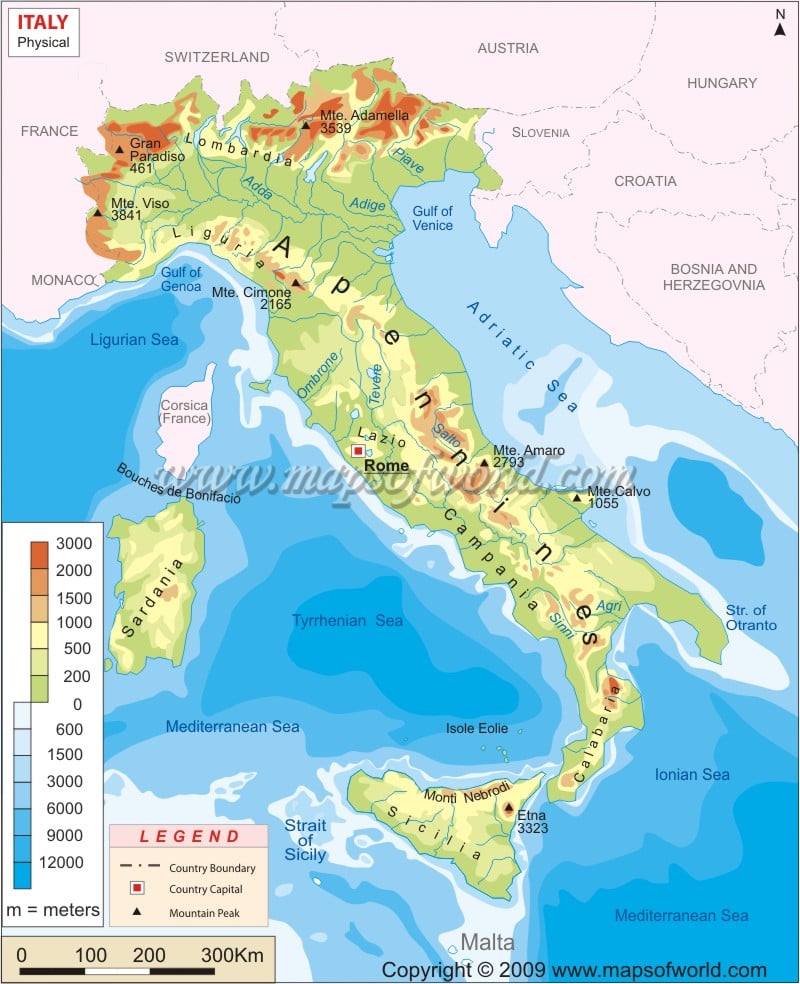- Italy Cities - Bari, Bologna, Brescia, Cagliari, Catania, Como, Florence, Genova, Livorno, Lucca, Milan, Modena, Naples, Palermo, Perugia, Pescara, Pistoia, Reggio Emilia, Rimini, Turin
- Italy Regions - Abruzzo, Aosta Valley, Apulia (Puglia), Basilicata, Calabria, Campania, Emilia Romagna, Friuli-Venezia Giulia, Lazio, Liguria, Lombardy, Marche, Molise, Piedmont, Sardinia, Sicily, Trentino, Tuscany (Toscana), Umbria, Veneto
- Neighboring Countries - Croatia, France, Austria, Switzerland, Monaco
- Continent And Regions - Europe Map
- Other Italy Maps - Italy Map, Where is Italy, Italy Blank Map, Italy Road Map, Italy Rail Map, Italy River Map, Italy Flag, Is Sicily a Country?
Italy, known as the Republic of Italy, is in south-central Europe. The country is located in the middle of the Mediterranean Sea. Italy shares land boundaries with Switzerland, France, Slovenia, Austria, and the enclaved microstates of San Marino and Vatican City. Italy covers the total area of 301, 230km2 (116,310 sq mi) of which 294,020 km2 (113,522 sq mi) island.
Physical Features of Italy
The map is beneficial for school presentations and other purposes. A map legend at the bottom helps all the signs, characters, graphics, and symbols used throughout the map. Rome, Italy’s capital and largest city, is marked on the Italy Physical Map. The country consists of a peninsula delimited by the Alps and several islands. Its territory largely coincides with the homonymous geographical region. The topography of Italy can be divided into:
Apennine and Alps Mountains
The 40% Territory of Italy is approximately mountainous. The Alps form the northern boundary of the country, about 1000 km or 620 mi. The Alps surround the Po Valley to the north, east, and west of Italy. The highest peaks of the country are found in the Alps, such as Mount Viso (3841 m), Monte Resa (4,634 m), Mte Adamella (3539), and the highest peak of the Alps, Mont Blanc (4810 m).
The Apennine Mountains form the peninsula’s backbone, extending 1350 km (840 mi). These ranges consist of parallel smaller chains along the length of peninsular Italy. The Apennines mountain joins the Alpine mountain with the Colle di Cadibona Pass in the Ligurian Alps at Altare. Gran Sasso d’ Italia (2912 meters or 9,554 feet) is the highest peak of the Apennines range in Italy.
Hills in Italy
Hills in Italy are located in the central-southern part of the peninsula, in the pre-Alpine area, and along the sides of the Apennine ridge. The hilly reliefs have slight slopes and do not exceed about 800 meters or 2,600 feet. There are many Hilly stripes in the country. The first two hilly strips lie between the Apennine range and Adriatic coast and between the Alps and Po Valley. The hills of Langhe and Montferrat lie in the western part of Po Valley. The other hills in the country are Beneventane Hills in Campania, Tyrrhenian Anti-Apennine, Adriatic Anti-Apennine hills in Puglia, and Gargano Murge Hills.
Plains
in Italy
The plan covers 23.2% of Italian national territory. The Po Valley Plain constitutes 70% of the total plan area of the country and is the most extensive Plain in Italy, covering 46,000 km2 (18,000 sq mi). Po Valley Plain is divided into two parts:
- The high Plain bordering Alpine and Apennine rang.
- The low Plain is located in the valley’s center and extends up to the Po Delta.
The central plains in the country are Tavoliere delle Puglie, Plain of Campania, plain of Salento, and more.
Rivers and Lake System in Italy
Italy is surrounded by sea on three sides and has rich rivers and lakes (inland waters). The country’s longest and most significant river is the Po River (652 km or 405 mi). It flows west to east, running through the Po Valley that ends with the Delta’s Adriatic Sea. Other important rivers of the country are Adige River, Tiber River, Adda, Oglio and Ticino. Italy has more than 1000 lakes, including Garda Lake, Lake Maggiore, Lake Lesina, and more.
